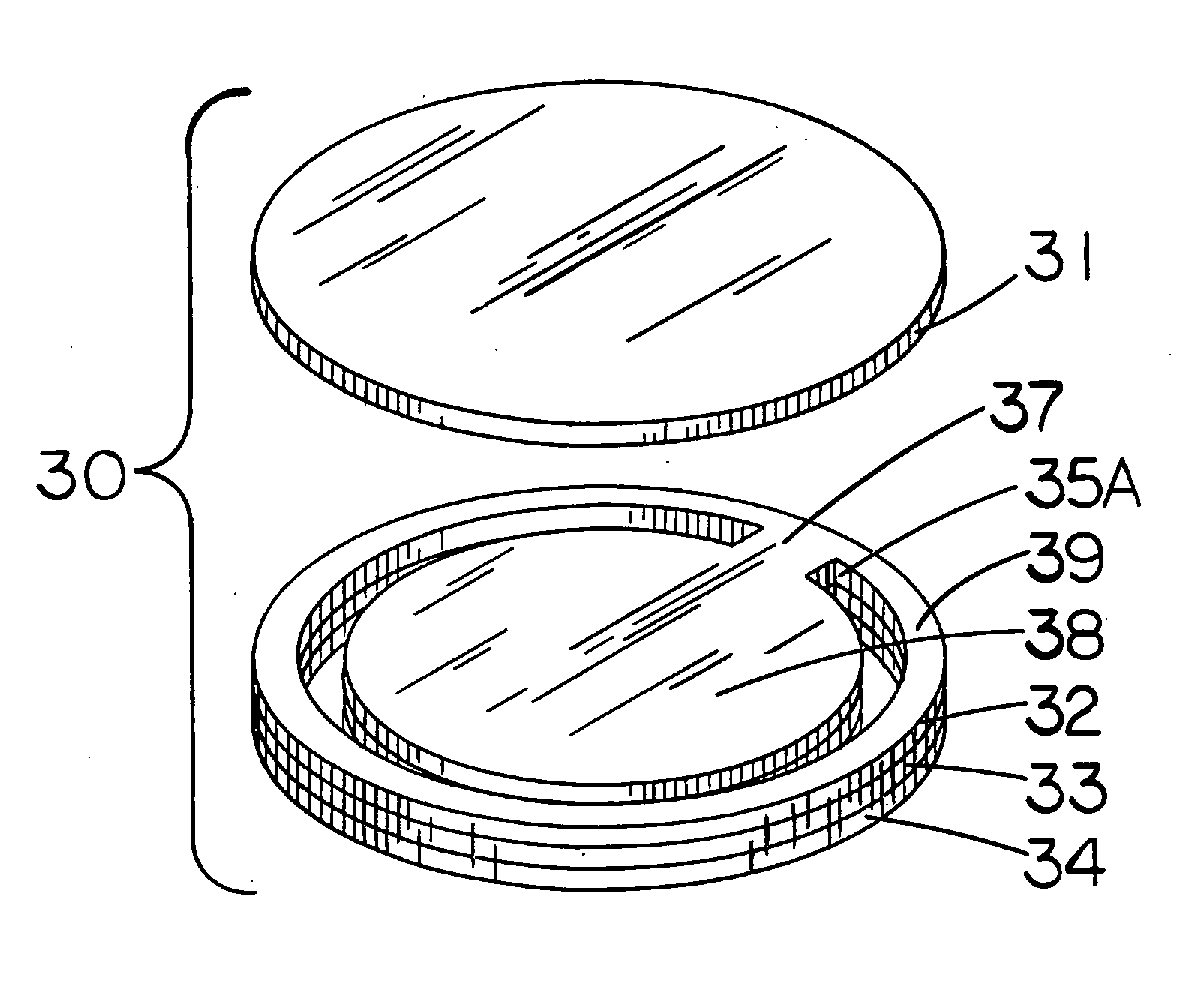Tamper evident container seal with integral pull opener
a technology of pull opener and container seal, which is applied in the direction of sealing, liquid handling, caps, etc., can solve the problems of weakness in the multi-layered seal only in the area of the c-shaped breaking pattern, and achieve the effect of easy opening, easy breaking and high resistan
- Summary
- Abstract
- Description
- Claims
- Application Information
AI Technical Summary
Benefits of technology
Problems solved by technology
Method used
Image
Examples
first embodiment
[0123] In this first embodiment adhesive layer 34 is comprised of a high strength, microencapsulated, reactive type adhesive to bond seal 30 to container 40 rim 41. Micro encapsulated adhesives are comprised of hollow spheres that can contain various types of single component, or two component adhesives such as resin and hardener. Seal 30 can be bonded to container 40 rim 41 by either melting the shell of the spheres during an induction sealing process, or the shells can be broken by the compression applied to rim contact portion 39 of seal 30 when closure cap 47 is installed. When the shell of the spheres are melted by heat or broken by compression, either a single component adhesive, or a two component adhesive that combines to initiate a curing reaction, bonds seal 30 to the container 40 rim 41. When fully dried or cured, hardened adhesive layer 34 creates a high strength bond that prevents rim contact portion 39 of seal 40 from being removed from rim 41 by force, or by the actio...
second embodiment
[0129] In this second embodiment adhesive layer 34 is comprised of a heat activated, high strength, hot melt type adhesive to bond seal 30 to container 40 rim 41. Heat generated in seal 30 during the installation process melts adhesive layer 34 which after cooling, bonds seal 30 to container 40 rim 41. When cooled, adhesive layer 34 creates a high strength bond that makes rim contact portion 39 of seal 30 resistant to surreptitious removal from rim 41 by force or by the action of solvents.
[0130] Although the use of this type of adhesive does not prevent seal 30 from being removed from rim 41 intact, and then replaced by the application of heat, it does provide a lower cost, tamper evident, pull open, leak proof seal 30 that can be used to seal containers 40 of ingestible and non ingestible products such as cosmetics, or skin cream etc. where product safety is also important.
[0131] Hot melt adhesives suitable for this purpose are widely used throughout the packaging industry and cos...
third embodiment
[0136] In this third embodiment, adhesive layer 34 is comprised of a heat activated, low strength, hot melt type adhesive to bond seal 30 to container 40 rim 41. Heat generated in seal 30 during the installation process melts adhesive layer 34, which after cooling, bonds seal 30 to container 40 rim 41. When cooled, adhesive layer 34 creates a low strength bond that is stronger than the strength of seal 30 in the area of breaking pattern 35A and, at the same time, weaker than the strength of pull tab 38 connector 37. When seal 30 is broken open and pull tab 38 is pulled, the low strength bond of adhesive layer 34 allows rim contact portion 39 of seal 30 to peel off container 40 rim 41 along with pull tab 38. Rim contact portion 39 remains attached to pull tab 38 which allows all of seal 30 to be completely removed from container 40 when pull tab 38 is pulled as further shown in FIG. 9.
[0137] Although using this weaker type of heat activated adhesive does not provide the same level of...
PUM
 Login to View More
Login to View More Abstract
Description
Claims
Application Information
 Login to View More
Login to View More - R&D
- Intellectual Property
- Life Sciences
- Materials
- Tech Scout
- Unparalleled Data Quality
- Higher Quality Content
- 60% Fewer Hallucinations
Browse by: Latest US Patents, China's latest patents, Technical Efficacy Thesaurus, Application Domain, Technology Topic, Popular Technical Reports.
© 2025 PatSnap. All rights reserved.Legal|Privacy policy|Modern Slavery Act Transparency Statement|Sitemap|About US| Contact US: help@patsnap.com



